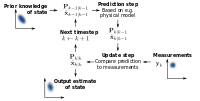
Photo from wikipedia
Abstract In this work, we introduce a stochastic prediction method which can be utilized in applications such as cooperative adaptive cruise control (CACC) to predict interfering vehicles’ movements. One of… Click to show full abstract
Abstract In this work, we introduce a stochastic prediction method which can be utilized in applications such as cooperative adaptive cruise control (CACC) to predict interfering vehicles’ movements. One of the main criteria in the design of automated vehicle systems is their robustness against the disturbances resulted from the non-homogeneity of the vehicular environment. The non-homogeneity is mainly due to the human-driven and automated/autonomous vehicles co-existence. It is therefore imperative for the automated applications to be designed with the capability of handling the uncertain behaviors of human-driven vehicles in a robust manner. This paper presents a method for vehicle movements time-series forecasting using a powerful non-parametric Bayesian inference method, namely Gaussian Processes. The proposed methodology is evaluated using realistic vehicle trajectory data from NGSIM dataset and is shown to provide more accurate results compared to baseline methods that use constant velocity coasting.
Journal Title: IFAC-PapersOnLine
Year Published: 2019
Link to full text (if available)
Share on Social Media: Sign Up to like & get
recommendations!